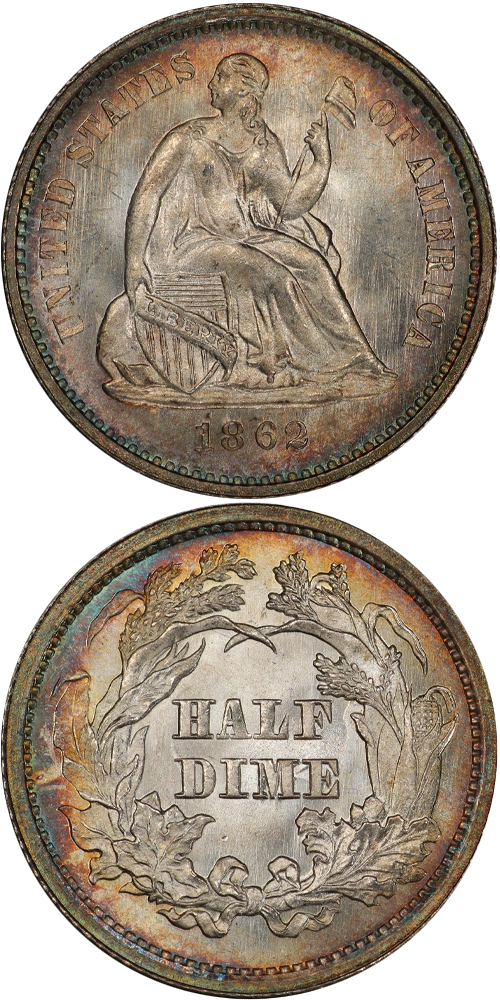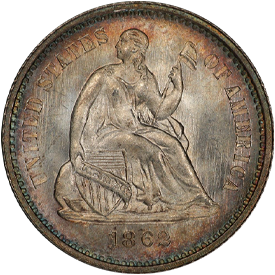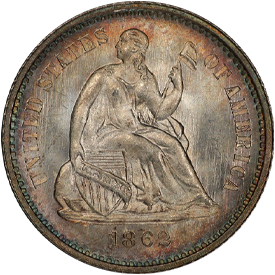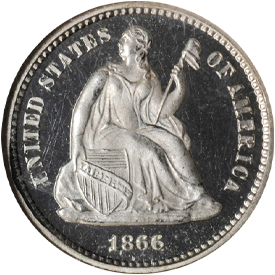Designed by: Christian Gobrecht
Issue Dates: 1860-1873
Composition: 90% silver, 10% copper
Diameter: 15.5 mm
Weight: 1.24 grams (19.2 grains)
Edge: Reeded
Business Strike Mintage: 15,552,600
Proof Mintage: 10,040
In the half dime (and also the dime) series a modification to the design occurred in 1860. The Liberty Seated motif was retained as the central obverse design, but the peripheral stars were eliminated in favor of the inscription UNITED STATES OF AMERICA, which previously had appeared around the border of the reverse. The date remained below Liberty. The reverse wreath was restyled to a larger format without lettering at the border, enclosing the denomination expressed as HALF DIME. This style was continued through 1873, at which time the half dime denomination was terminated.
The type set collector will have no difficulty acquiring a commoner date in this era in any desired grade from Very Good to AU. Uncirculated pieces are harder to find, and superb Uncirculated half dimes are quite scarce. Proofs were issued to collectors and are generally available. Scattered among the common dates in the series are several scarce varieties, including several of the Philadelphia Mint issues.
Further Reading
In 1860 the regular half dime design was changed. The stars on the obverse were replaced by the inscription UNITED STATES OF AMERICA. The reverse wreath was changed to a larger and bulkier style. Half dimes of this design were made from 1860 through 1873 inclusive.
Among these later half dimes are several scarce varieties, including Philadelphia Mint issues 1863 through 1867 inclusive. San Francisco Mint coins of the period 1863-1869 are quite scarce in higher grades. Among San Francisco coins of the 1860s and early 1870s are numerous pieces which have the Liberty Seated figure on the obverse engraved, as if by a scraping tool. Obviously, an attempt was made to shave off silver from the figure, but this was done by following the contours of the Liberty Seated figure so as not to make the removal obvious except upon close inspection. Examples showing this are sufficiently common that there must have been a widespread reason for doing this. Probably the explanation is that these pieces were exported in quantity to the Orient, and silver was shaved off by various merchants there who desired to amass silver on a bit-by-bit basis. A flaw in this theory is that trade dollars, which were circulated in large quantities in the Orient at the same time, rarely show this feature. Certain of these scraped half dimes show button shanks mounted on the back, another mystery. The writer once purchased a small group of about 200 San Francisco half dimes of this era, and each had the scraped feature.
One of the most marvelous numismatic discoveries in recent decades is the 1870-S half dime. Prior to a few years ago no one dreamed that an 1870-S half dime existed. Indeed, no such coin is mentioned in the Mint reports. Apparently sloppy records were kept in San Francisco in 1870, for there is no mintage record of the 1870-S silver dollar either, and yet a number of such dollars exist (and are great rarities). Rarcoa, the Chicago firm, dazzled the hobby in the 1970s by announcing that an 1870-S half dime had come to light. The piece was exhibited at several conventions. I had the privilege of examining it closely. The piece, being a new discovery, had not been publicized earlier and was not famous. However, such fame will surely come. The unique 1870-S half dime was sold to John Abbott, the well-known Michigan professional numismatist. Secretly I wished that it had been consigned to one of our auction sales instead, for it would have been interesting to have researched the piece in detail and to have presented it in a multiple page spread.
The selling price of $425,000 for the piece, as subsequently reported in A Guide Book of United States Coins, was said to have been derived in an unusual manner. What is the coin worth? The thought went through the minds of Ed Milas and Dennis Forgue, the owners of Rarcoa. It was decided that when my firm auctioned the Garrett Collection (as part of a series of sales we were conducting for The Johns Hopkins University) – the selling price of the 1804 silver dollar plus $25,000, would be a reasonable figure for the unique 1870-S. In a fantastic "fight" among enthusiastic bidders on the auction floor, the 1804 silver dollar broke all past records and soared to $400,000, thus setting the auction sale record for any United States silver coin! As agreed beforehand, $25,000 was added to the price, and $425,000 became the transaction basis for the 1870-S half dime. In 2004, the coin was sold by Stack’s Bowers for $661,250 and the current edition of the Guidebook lists it at $2 million!
In 1872 two half dime varieties were created at the San Francisco Mint, one with a mintmark above the wreath bow and the other with a mintmark below. The year 1873 saw several series end their existence. Not only did production of the half dime end, but two-cent pieces and silver three-cent pieces were discontinued as well.
During the last decade or so of the half dime denomination pieces were not released into circulation at the time of coinage but were stored by the Treasury. During the period specie payments were suspended, and silver coins did not circulate. The gap was filled by nickel five cent pieces of the same value.
Worn and Proof half dimes of the type from 1860 through the end of the series in 1873 are available in proportion to their original mintages. Pieces from the Philadelphia Mint from 1863 through 1867 in particular are elusive. Higher mintages were recorded for the San Francisco emissions. While numerous examples were stored by the Treasury Department during the specie payment suspension years, it is probable that a good share of them were sent overseas in payment for various supplies. This would explain the earlier-mentioned pieces which presumably were engraved in the Orient.
So far as Uncirculated pieces are concerned, those most often seen of the 1860-1873 type are 1861 and 1862 Philadelphia as well as 1871, 1872, 1872-S, 1873, and 1873-S.









